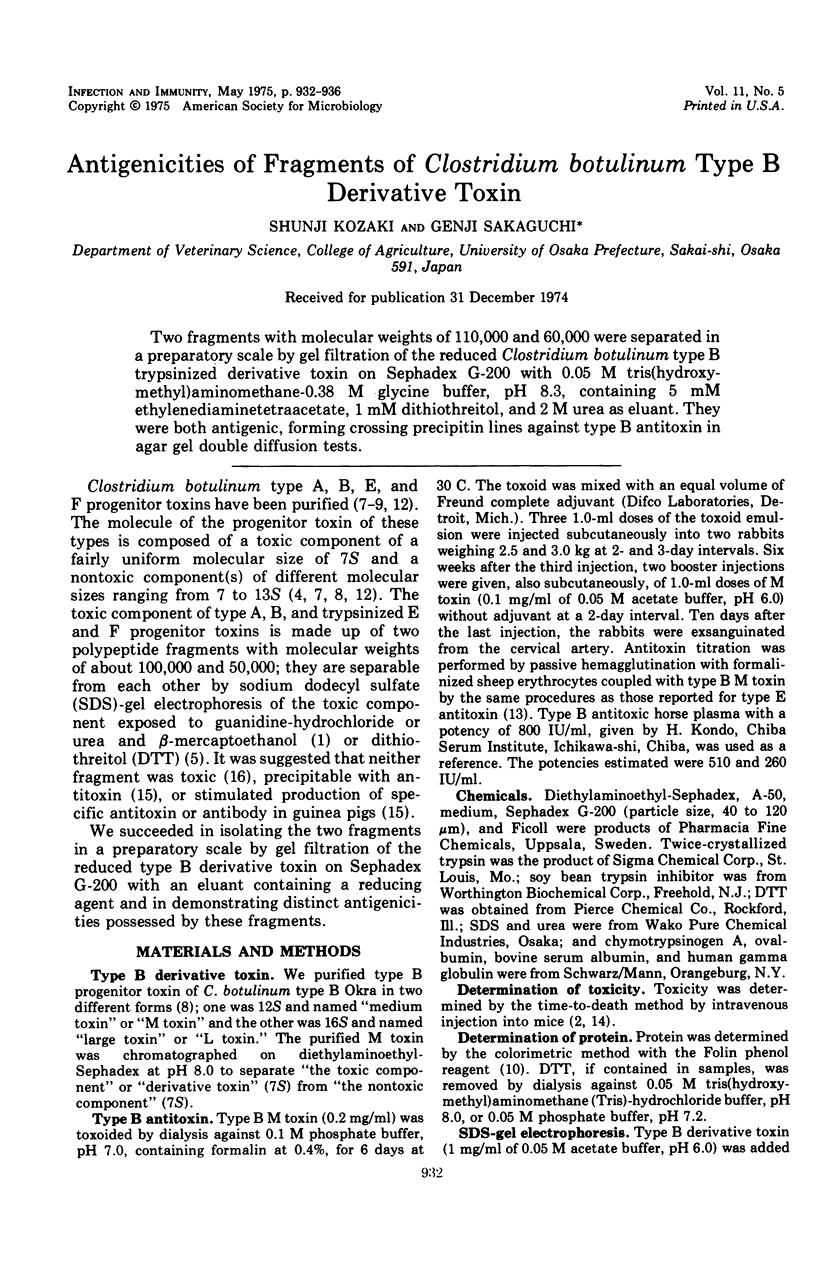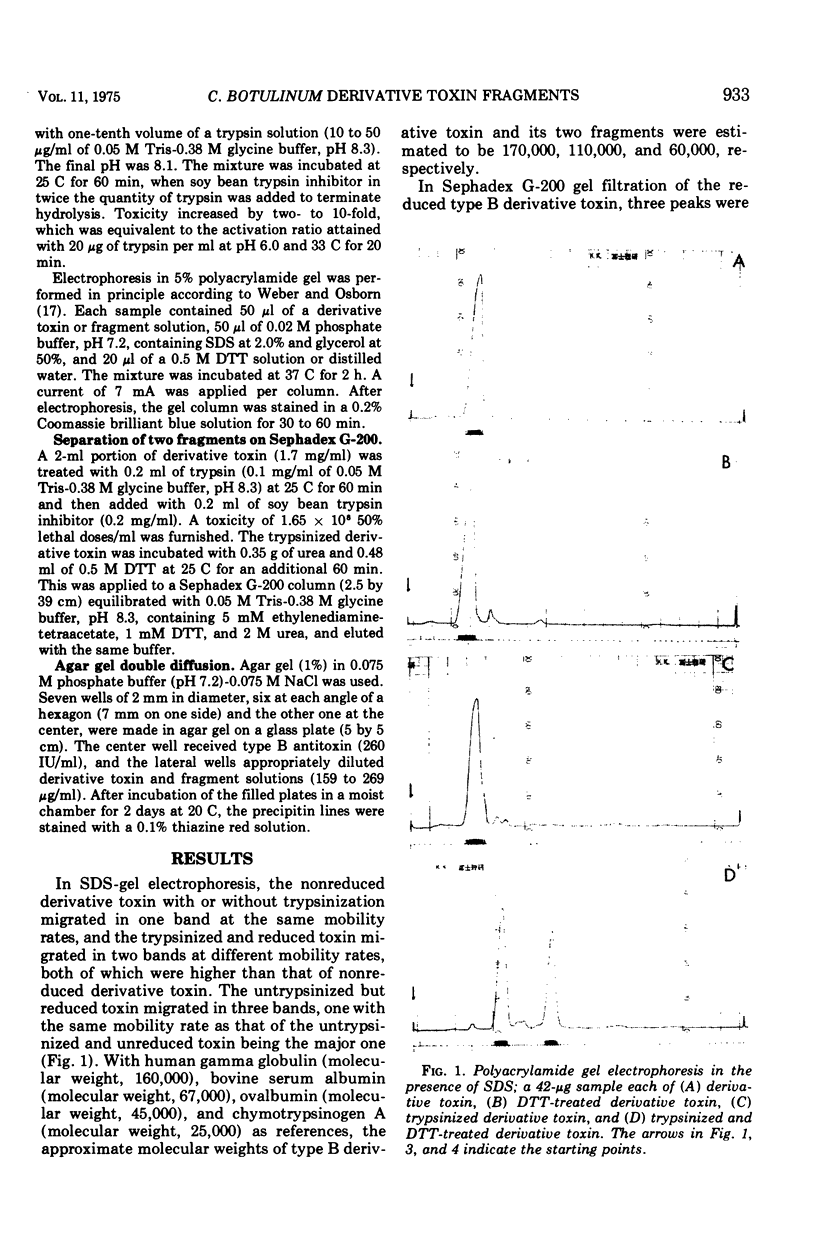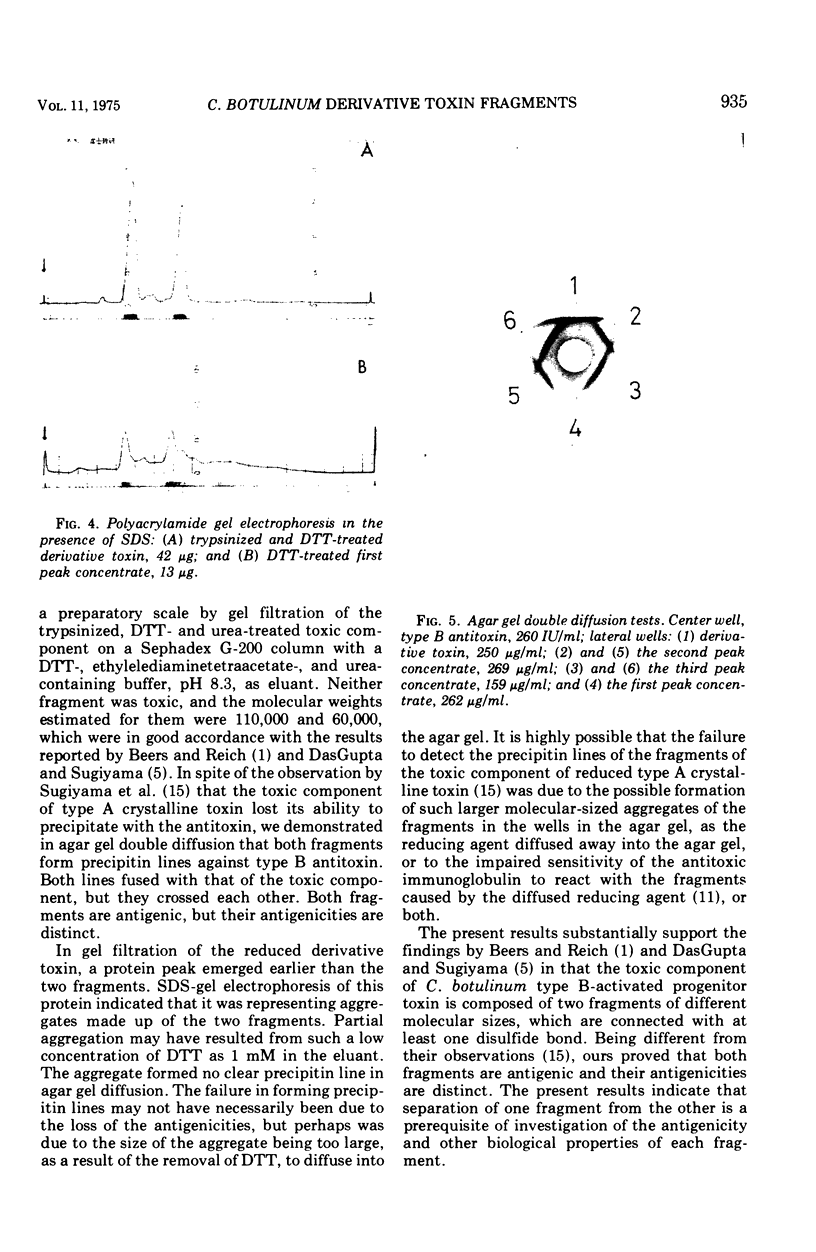Abstract
Two fragments with molecular weights of 110,000 and 60,000 were separated in a preparatory scale by gel filtration of the reduced Clostridium botulinum type B trypsinized derivative toxin on Sephadex G-200 with 0.05 M tris(hydroxymethyl)aminomethane-0.38 M glycine buffer, pH 8.3, containing 5 mM ethylenediaminetetraacetate, 1 mM dithiothreitol, and 2 M urea as eluant. They were both antigenic, forming crossing precipitin lines against type B antitoxin in agar gel double diffusion tests.
Full text
PDF




Images in this article
Selected References
These references are in PubMed. This may not be the complete list of references from this article.
- Beers W. H., Reich E. Isolation and characterization of Clostridium botulinum type B toxin. J Biol Chem. 1969 Aug 25;244(16):4473–4479. [PubMed] [Google Scholar]
- Boroff D. A., Fleck U. Statistical analysis of a rapid in vivo method for the titration of the toxin of Clostridium botulinum. J Bacteriol. 1966 Nov;92(5):1580–1581. doi: 10.1128/jb.92.5.1580-1581.1966. [DOI] [PMC free article] [PubMed] [Google Scholar]
- Collier R. J., Kandel J. Structure and activity of diphtheria toxin. I. Thiol-dependent dissociation of a fraction of toxin into enzymically active and inactive fragments. J Biol Chem. 1971 Mar 10;246(5):1496–1503. [PubMed] [Google Scholar]
- DasGupta B. R., Sugiyama H. A common subunit structure in Clostridium botulinum type A, B and E toxins. Biochem Biophys Res Commun. 1972 Jul 11;48(1):108–112. doi: 10.1016/0006-291x(72)90350-6. [DOI] [PubMed] [Google Scholar]
- Dasgupta B. R., Boroff D. A., Rothstein E. Chromatographic fractionation of the crystalline toxin of Clostridium botulinum type A. Biochem Biophys Res Commun. 1966 Mar 22;22(6):750–756. doi: 10.1016/0006-291x(66)90212-9. [DOI] [PubMed] [Google Scholar]
- Gill D. M., Dinius L. L. Observations on the structure of diphtheria toxin. J Biol Chem. 1971 Mar 10;246(5):1485–1491. [PubMed] [Google Scholar]
- Kitamura M., Sakaguchi S., Sakaguchi G. Purification and some properties of Clostridium botulinum type-E toxin. Biochim Biophys Acta. 1968 Oct 21;168(2):207–217. doi: 10.1016/0005-2795(68)90144-x. [DOI] [PubMed] [Google Scholar]
- Kozaki S., Sakaguchi S., Sakaguchi G. Purification and some properties of progenitor toxins of Clostridium botulinum type B. Infect Immun. 1974 Oct;10(4):750–756. doi: 10.1128/iai.10.4.750-756.1974. [DOI] [PMC free article] [PubMed] [Google Scholar]
- LOWRY O. H., ROSEBROUGH N. J., FARR A. L., RANDALL R. J. Protein measurement with the Folin phenol reagent. J Biol Chem. 1951 Nov;193(1):265–275. [PubMed] [Google Scholar]
- Mestrandrea L. W. Rapid detection of Clostridium botulinum toxin by capillary tube diffusion. Appl Microbiol. 1974 Jun;27(6):1017–1022. doi: 10.1128/am.27.6.1017-1022.1974. [DOI] [PMC free article] [PubMed] [Google Scholar]
- Oishi I., Sakaguchi G. Purification of Clostridium botuliunum type F progenitor toxin. Appl Microbiol. 1974 Dec;28(6):923–928. doi: 10.1128/am.28.6.923-928.1974. [DOI] [PMC free article] [PubMed] [Google Scholar]
- Sakaguchi G., Sakaguchi S. Development of antibody to each component of Clostridium botulinum type E progenitor toxin. Jpn J Med Sci Biol. 1973 Dec;26(5):187–195. doi: 10.7883/yoken1952.26.187. [DOI] [PubMed] [Google Scholar]
- Sakaguchi G., Sakaguchi S., Kondo H. Rapid bioassay for Clostridium botulinum type-E toxins by intravenous injection into mice. Jpn J Med Sci Biol. 1968 Dec;21(6):369–378. doi: 10.7883/yoken1952.21.369. [DOI] [PubMed] [Google Scholar]
- Statement by Senator Willis Introducing a Bill for a National Science Foundation. Science. 1946 Feb 8;103(2667):163–164. doi: 10.1126/science.103.2667.163. [DOI] [PubMed] [Google Scholar]
- Sugiyama H., Das Gupta R., Yang K. H. Disulfide-toxicity relationship of botulinal toxin types A, E, and F. Proc Soc Exp Biol Med. 1973 Jul;143(3):589–591. doi: 10.3181/00379727-143-37372. [DOI] [PubMed] [Google Scholar]
- Sugiyama H., DasGupta B. R., Oishi I. Disulfide-immunogenicity relationship of botulinal toxins. Proc Soc Exp Biol Med. 1974 Apr;145(4):1306–1309. doi: 10.3181/00379727-145-38002. [DOI] [PubMed] [Google Scholar]
- Weber K., Osborn M. The reliability of molecular weight determinations by dodecyl sulfate-polyacrylamide gel electrophoresis. J Biol Chem. 1969 Aug 25;244(16):4406–4412. [PubMed] [Google Scholar]






